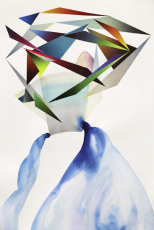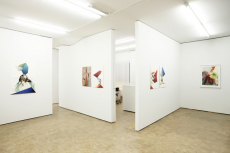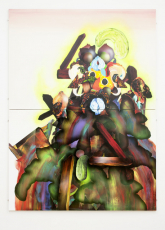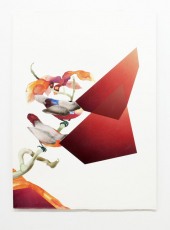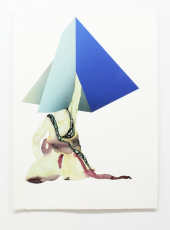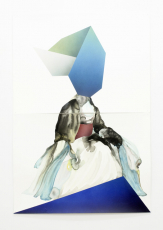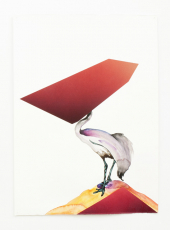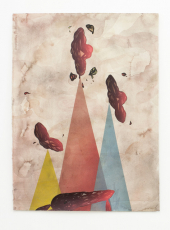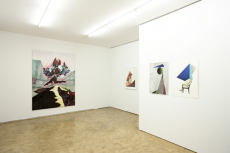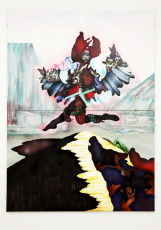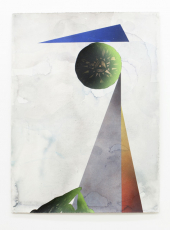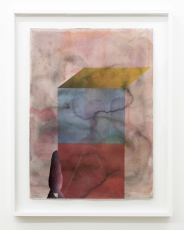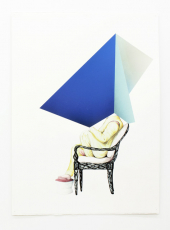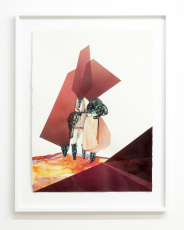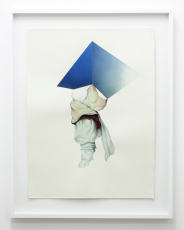Haroun Haward
Mythologies
28.01. – 03.03.2012
Opening, 27 January, 18–21 h
Opening, 27 January, 18–21 h

The Mountain
2011
acrylic, spray-paint on paper, framed
76 × 56 cm
photo: Gian Paul Lozza
acrylic, spray-paint on paper, framed
76 × 56 cm
photo: Gian Paul Lozza

exhibition view
photo: Gian Paul Lozza
photo: Gian Paul Lozza
«Look at the apple, look at the peach, how round and full of life, cheeks to right and left; notice, too, my eyes, of which one cerise, the other mulberry. Outside I look a monster, inside I bear noble traits, concealing a royal portrait.»
Don Gregono Comanini
‹The Vertumnus of Arcimboldo›, 1591
We are delighted to announce the first solo exhibition of the young British painter Haroun Haward at Herrmann Germann Contemporary. Born in 1983, Haward lives and works in London. After earning a Bachelor of Arts in Fine Arts from Brighton University (1st Class Honours), and following an exchange stay at Nagoya University of Arts in Japan, Haward was artist-in-residence at the Traditional Miniature Painting Department of Pakistan’s National College of Arts in Lahore. He completed his MFA in Fine Arts at London’s Goldsmiths University in 2010.
In ‹The Castle of Crossed Destinies›, Italo Calvino describes various wonderous events and fates through a sequence of playing cards. These images, along with the interpreted verbal surface, form a self-contained narrative cycle based on fifteenth- and eighteenth-century tarot games. Just as in Calvino’s novel, Haroun Haward’s paintings are about tradition, narration, and interpretation. His narratives range from the history of the Northern Renaissance through the Persian Mogul Empire (1526–1858) to the present. Born and raised in North London to an English father and a Pakistani mother, Haward was raised in a cosmopolitan atmosphere of two cultures and their historical legacies.
While Haward’s earlier work juxtaposed eastern and western motifs and symbols, he currently aspires to a dense, many-layered narrative and the possibilities this offers. ‹Mythologies› consists of several large-scale panels and nine works on paper. Composed especially for the forthcoming exhibition, these works pursue various approaches to pancultural narration. They fuse stories and myths from various cultures with comic elements and others referring to animation films, computer games, the cover designs of heavy metal albums, and meta-literature. Blending various techniques and colours on one and the same surface, Haward brings to life both stylistic and cultural hybrids. He employs a range of technical means, from the coarse ‹fat cap› (a spray can nozzle) to the miniature brush, to create two-dimensional collages and models that both invite and require close scrutiny.
Kindly supported by Kyburz&Peck — English Language Projects
Don Gregono Comanini
‹The Vertumnus of Arcimboldo›, 1591
We are delighted to announce the first solo exhibition of the young British painter Haroun Haward at Herrmann Germann Contemporary. Born in 1983, Haward lives and works in London. After earning a Bachelor of Arts in Fine Arts from Brighton University (1st Class Honours), and following an exchange stay at Nagoya University of Arts in Japan, Haward was artist-in-residence at the Traditional Miniature Painting Department of Pakistan’s National College of Arts in Lahore. He completed his MFA in Fine Arts at London’s Goldsmiths University in 2010.
In ‹The Castle of Crossed Destinies›, Italo Calvino describes various wonderous events and fates through a sequence of playing cards. These images, along with the interpreted verbal surface, form a self-contained narrative cycle based on fifteenth- and eighteenth-century tarot games. Just as in Calvino’s novel, Haroun Haward’s paintings are about tradition, narration, and interpretation. His narratives range from the history of the Northern Renaissance through the Persian Mogul Empire (1526–1858) to the present. Born and raised in North London to an English father and a Pakistani mother, Haward was raised in a cosmopolitan atmosphere of two cultures and their historical legacies.
While Haward’s earlier work juxtaposed eastern and western motifs and symbols, he currently aspires to a dense, many-layered narrative and the possibilities this offers. ‹Mythologies› consists of several large-scale panels and nine works on paper. Composed especially for the forthcoming exhibition, these works pursue various approaches to pancultural narration. They fuse stories and myths from various cultures with comic elements and others referring to animation films, computer games, the cover designs of heavy metal albums, and meta-literature. Blending various techniques and colours on one and the same surface, Haward brings to life both stylistic and cultural hybrids. He employs a range of technical means, from the coarse ‹fat cap› (a spray can nozzle) to the miniature brush, to create two-dimensional collages and models that both invite and require close scrutiny.
Kindly supported by Kyburz&Peck — English Language Projects
«Look at the apple, look at the peach, how round and full of life, cheeks to right and left; notice, too, my eyes, of which one cerise, the other mulberry. Outside I look a monster, inside I bear noble traits, concealing a royal portrait.»
Don Gregono Comanini
‹The Vertumnus of Arcimboldo›, 1591
Wir freuen uns die erste Einzelausstellung des britischen Malers Haroun Haward bei Herrmann Germann Contemporary anzukündigen.
Der 1983 in London geborene Künstler, lebt und arbeitet in London. Nach dem Bachelor of Arts an der Brighton University in Fine Art Painting (1st Class mit Auszeichnung) und einem Studienaustausch an der Nagoya University of Arts in Japan, absolvierte Haward einen Gastkünstleraufenthalt am National College of Arts in Traditional Miniature Painting Department in Lahore, Pakistan. 2010 schliesst er an der Goldsmiths University London den MFA in Fine Arts ab.
Italo Calvino beschreibt in seinem Buch ‹Das Schloss, darin sich Schicksale kreuzen› wundersame Schicksale in Bildabfolgen eines Kartenspiels. Mit der interpretierten Wortebene entsteht ein geschlossener Erzählzyklus basierend auf Tarockspielen aus dem 15. bzw. 18. Jahrhundert. Wie in Calvinos Buch geht es in Haroun Hawards Gemälden um Überlieferung, Geschichtenerzählung und Interpretation. Sein Spektrum der Narration umfasst gleichwohl die Kunstgeschichte der nordischen Renaissance als auch des persischen Mogulreichs (1526–1858) bishin zur Gegenwart. Geboren und aufgewachsen in Nord-London als Sohn eines englischen Vaters und einer pakistanischen Mutter wächst Haward in einer kosmopolitischen Atmosphäre zweier Kulturen und dessen historischen Erbes auf.
Wo in Hawards frühreren Arbeiten Nebeneinanderstellungen von Ost- und West-Motiven und Symbolen erkennbar waren, strebt er in seinen aktuellen Arbeiten eine dichte, vielschichtige Qualität der Erzählebenen und damit verbundenen Möglichkeiten an. ‹Mythologies› umfasst mehrere grossformatige Tafelbilder und neun Arbeiten auf Papier. Die eigens für die Ausstellung gefertigten Werke verfolgen unterschiedliche Ansätze der pankulturellen Erzählung. Sie verschmelzen Geschichten und Mythen mit Komponenten, die sich auf Comics, Animationsfilme, Computerspiele, Heavy-Metal-Album-Designs und Meta-Literatur referenzieren. Beim Verschmelzen verschiedener Techniken und Arten von Farbe auf der gleichen Fläche bildet Haward stilistische als auch kulturelle Hybride. Er collagiert und modelliert im zweidimensionalen Raum mit Werkzeugen von der groben ‹fat cap› (Düsenaufsatz einer Sprühdose) bis zum Miniatur-Pinsel.
Mit freundlicher Unterstützung von Kyburz&Peck — English Language Projects
Don Gregono Comanini
‹The Vertumnus of Arcimboldo›, 1591
Wir freuen uns die erste Einzelausstellung des britischen Malers Haroun Haward bei Herrmann Germann Contemporary anzukündigen.
Der 1983 in London geborene Künstler, lebt und arbeitet in London. Nach dem Bachelor of Arts an der Brighton University in Fine Art Painting (1st Class mit Auszeichnung) und einem Studienaustausch an der Nagoya University of Arts in Japan, absolvierte Haward einen Gastkünstleraufenthalt am National College of Arts in Traditional Miniature Painting Department in Lahore, Pakistan. 2010 schliesst er an der Goldsmiths University London den MFA in Fine Arts ab.
Italo Calvino beschreibt in seinem Buch ‹Das Schloss, darin sich Schicksale kreuzen› wundersame Schicksale in Bildabfolgen eines Kartenspiels. Mit der interpretierten Wortebene entsteht ein geschlossener Erzählzyklus basierend auf Tarockspielen aus dem 15. bzw. 18. Jahrhundert. Wie in Calvinos Buch geht es in Haroun Hawards Gemälden um Überlieferung, Geschichtenerzählung und Interpretation. Sein Spektrum der Narration umfasst gleichwohl die Kunstgeschichte der nordischen Renaissance als auch des persischen Mogulreichs (1526–1858) bishin zur Gegenwart. Geboren und aufgewachsen in Nord-London als Sohn eines englischen Vaters und einer pakistanischen Mutter wächst Haward in einer kosmopolitischen Atmosphäre zweier Kulturen und dessen historischen Erbes auf.
Wo in Hawards frühreren Arbeiten Nebeneinanderstellungen von Ost- und West-Motiven und Symbolen erkennbar waren, strebt er in seinen aktuellen Arbeiten eine dichte, vielschichtige Qualität der Erzählebenen und damit verbundenen Möglichkeiten an. ‹Mythologies› umfasst mehrere grossformatige Tafelbilder und neun Arbeiten auf Papier. Die eigens für die Ausstellung gefertigten Werke verfolgen unterschiedliche Ansätze der pankulturellen Erzählung. Sie verschmelzen Geschichten und Mythen mit Komponenten, die sich auf Comics, Animationsfilme, Computerspiele, Heavy-Metal-Album-Designs und Meta-Literatur referenzieren. Beim Verschmelzen verschiedener Techniken und Arten von Farbe auf der gleichen Fläche bildet Haward stilistische als auch kulturelle Hybride. Er collagiert und modelliert im zweidimensionalen Raum mit Werkzeugen von der groben ‹fat cap› (Düsenaufsatz einer Sprühdose) bis zum Miniatur-Pinsel.
Mit freundlicher Unterstützung von Kyburz&Peck — English Language Projects

